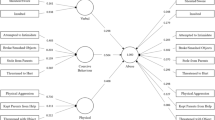Abstract
Coercion theory provided the theoretical rationale for the present study. The hypothesis was that mothers' reports of child behavior problems and mothers' reports of external locus of control would be related to abuse potential. A total of 95 mother-child pairs were screened for child abuse potential during visits to a hospital-based pediatrie clinic. Following brief interviews, mothers completed three measures: Milner's Child Abuse Potential Inventory, Levenson's Locus of Control Scales, and the Revised Behavior Problem Checklist. Perceptions of control by powerful others and by chance were related to abuse potential for mothers of both sexes. Mothers' reports of their sons' anxiety-withdrawal and conduct-disorder behavior problems were related to abuse potential. There was a significant association among lie scores, internality, and abuse potential for mothers of female children. Mothers with high abuse potential reported significantly more behavior problems in their children. The findings were discussed in relation to coercion theory.
Similar content being viewed by others
References
Bee, H. L., Disbrow, M. A., Johnson-Crowley, N., & Barnard, K. (1981, April).Parent-child interaction during teaching in abusing and nonabusing families. Paper presented at the biennial meeting of the Society for Research in Child Development, Boston.
Burgess, R. L., & Conger, R. D. (1978). Family interaction in abusive, neglectful, and normal families.Child Development, 49(4), 1163–1173.
Conger, R. F. (1981). Assessment of dysfunctional family systems. In B. Lashley & A. Kazdin (Eds.),Advances in clinical child psychology (Vol. 4, pp. 219–242). New York: Plenum Press.
Draper, T. W. (1982). Sons, mothers, and externality: Is there a father effect?Child Study Journal, 12(4), 271–280.
Ellis, R. H., & Milner, J. S. (1981). Child abuse and locus of control.Psychological Reports, 48, 507–510.
George, C., & Main, M. (1979). Social interactions of young abused children: Approach, avoidance and aggression.Child Development, 50(2), 306–318.
Hetherington, E. M., Cox, M., & Cox, R. (1981). The aftermath of divorce. In E. M. Hetherington & R. D. Parke (Eds.),Contemporary readings in child psychology (Vol. 1, pp. 234–248). New York: McGraw-Hill.
Hetherington, E. M., & Martin, B. (1979). Family interaction. In H. C. Quay & J. S. Werry (Eds.),Psychopathological disorders of childhood. New York: Wiley.
Levenson, H. (1981). Differentiating among externality, powerful others and chance. In H. M. Lefcourt (Ed.),Research with the locus of control construct (Vol. 1, pp. 15–63). New York: Academic Press.
Lewis, M., & Schaeffer, S. (1981). Peer behavior and mother-infant interaction in maltreated children. In M. Lewis & L. A. Rosenblum (Eds.),The uncommon child (Vol. 1, pp. 193–223). New York: Plenum Press.
Martin, J. A. (1981). A longitudinal study of the consequences of early mother-infant interaction: A microanalytic approach.Monographs of the Society for Research in Child Development, 46(3, Serial No. 190).
Mash, E. J., Johnston, C., & Kovitz, K. (1983). A comparison of the mother-child interactions of physically abused and nonabused children during play and task situations.Journal of Clinical Child Psychology, 12(3), 337–346.
Milner, J. S. (1980).The child abuse potential inventory: Manual. Webster, North Carolina: Psytec.
Patterson, G. R. (1980). Mothers: The unacknowledged victims.Monographs of Society for Research in Child Development, 45(5, Serial No. 186).
Patterson, G. R. (1982). Coercive family process: A social learning approach (Vol. 3). Eugene: Castalia.
Quay, H. C. (1983). A dimensional approach to behavior disorder: The Revised Behavior Problem Checklist.School Psychology Review, 12, 244–249.
Quay, H. C., & Peterson, D. R. (1983, April).Interim manual for the Revised Behavior Problem Checklist. (Available from H. C. Quay, Box 248074, University of Miami, Coral Gables, Florida 33124.)
Reid, J. B., Patterson, G. R., & Loeber, R. (1981). The abused child: Victim, instigator, or innocent bystander?Nebraska Symposium on Motivation, 29, 47–68.
Robertson, K. R., & Milner, J. S. (1983). Construct validity of the Child Abuse Potential Inventory.Journal of Clinical Psychology, 39(3), 426–429.
Rotter, J. B. (1966).Generalized expectancies for external versus internal control of reinforcement.Psychological Monographs, 80(1, Whole No. 609).
Author information
Authors and Affiliations
Rights and permissions
About this article
Cite this article
Stringer, S.A., La Greca, A.M. Correlates of child abuse potential. J Abnorm Child Psychol 13, 217–226 (1985). https://doi.org/10.1007/BF00910643
Revised:
Issue Date:
DOI: https://doi.org/10.1007/BF00910643




